BestReviews is reader-supported and may earn an affiliate commission. Details
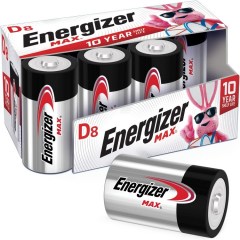
A dozen of Energizer's longest-lasting MAX D batteries; ideal for toys, flashlights, cameras, and gadgets.
Long shelf-life in the box, with 10 years of shelf-life in proper storage. Powerseal technology ensures that power goes where you want it to go both safely and effectively. Buyers love the reliable performance and a price that doesn't break the bank. Buyers note quality with a wide range of devices.
Some buyers may have accidentally ordered less-powerful batteries. Watch where you click.
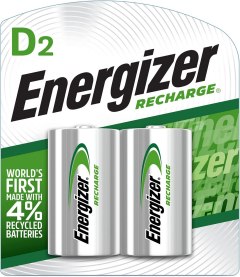
A pair of rechargeable D batteries with up to 3 years of life before they need replacing.
Energizer is among the most trusted names in batteries, and these long-lasting versions made from 7% recycled batteries save you the hassle of keeping too many D batteries around. Keep their charge for up to 1 month at a time. They're great for portable fans, lanterns, and other battery-powered accessories and appliances.
Charger not included.
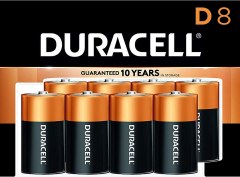
D batteries to power up your favorite toys and electronic devices, while unused batteries stay fresh for years.
Built to last long inside devices and on the shelf, with 10 years of storage life guaranteed. Added power over Duracell's standard batteries means long-lasting light in lamps and hours of fun with a favorite toy. Buyers praise the durability, with many noting Duracell's consistency compared to competitors.
Some reports of duds and faulty packages.
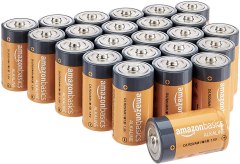
Affordable power from Amazon's house brand with 24 batteries and 5 years of shelf-life upon purchase.
Nearly double the batteries of several competitors with admirable performance compared to bigger brands. Ideal for toys and gadgets that suck up more batteries than the average device. Buyers praise the batteries for giving them a less expensive option.
Not ideal for lanterns, lamps, and other devices that benefit from a longer battery life.
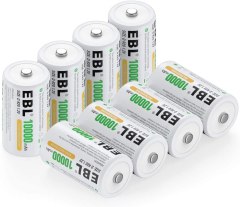
Rechargeable batteries that last 1,200 cycles for maximum performance.
Ideal for camping trips and other settings where power and space may be at a minimum. Parents love them for their child's baby monitors and toys, as they don't need to be constantly changed. May cost more upfront, but they quickly pay for themselves with regular use. Buyers love the convenience.
Charger not included. Less voltage than standard batteries.

We recommend these products based on an intensive research process that's designed to cut through the noise and find the top products in this space. Guided by experts, we spend hours looking into the factors that matter, to bring you these selections.

D batteries, or D-cells, are the most common large single-cell batteries in consumer use. Their size makes them ideal for devices that have high power requirements or long run times. D batteries, like AA, AAA, and C batteries, are single-cell batteries, meaning they are constructed around a single electrical cell. In contrast, 9-volt batteries contain six cells.
D cells are also dry cell batteries. Dry cell batteries have electrolytes in paste form, which are less prone to leakage than the liquid electrolytes of wet cell batteries. Car batteries are examples of wet cell batteries.
D cells were invented in 1898 to power flashlights, which were brought to the market the next year. Their creator, the National Carbon Company, eventually acquired the maker of the first battery-operated flashlights, the American Ever Ready Company, for which it supplied battery parts. The trademark was shortened to Eveready. The company eventually became part of Union Carbide and later Ralston Purina. It is currently Energizer Holdings, Inc. after its flagship battery brand.

D batteries, like other consumer batteries, differ in the cell chemistry they use. Batteries have different capabilities depending on their cell chemistry.
The two most common cell chemistries are carbon zinc and alkaline. Carbon zinc, known also as zinc-carbon, is the older technology, originally developed as a wet cell battery by French inventor Georges Leclanche in 1866. It was the primary kind of consumer battery available until the mid-twentieth century.
Alkaline batteries are the most popular battery on the market. Alkaline batteries are known for having larger capacities, longer durations, and longer shelf lives than carbon zinc batteries. They are better suited to intermittent or constant light loads than carbon zinc batteries. Alkaline batteries came to market in the 1960s.
Three other kinds of cell chemistry are commonly available in the D cell format: nickel cadmium, also called NiCad; nickel metal hydride, or NiMH; and lithium. These batteries have the capability of being conveniently recharged by the consumer.
Due to their capacity, D batteries are ideally used for high-power, high-drain duties. Large, heavy-duty flashlights were the original reason D batteries were invented and remained their most popular use for a long time. They’re also ideal for radio transmitters, classic boomboxes, radio-controlled toys and devices, and electric motors. D batteries have also been used to power emergency and weather radios, which can be lifesavers in natural disasters.
Rechargeable single-cell batteries have become a viable alternative to old-fashioned disposable batteries. While costing more upfront, they can be recharged multiple times, saving you money in the long run. By reducing waste, they can be more friendly to the environment, although they are made with heavy metals. If you choose rechargeable D batteries, you usually also need to purchase a battery recharger compatible with them.
Don’t throw your used batteries in the household trash. Many batteries use toxic materials including acids and heavy metals. Rechargeable batteries in particular need proper disposal when their lifespans run out. The only batteries safe to throw in household trash are alkaline batteries, which no longer contain the metal mercury. Dispose of all batteries according to your local waste authority’s guidelines.
A popular test for alkaline batteries involves dropping them to see if they bounce. However, what this really shows is whether they’ve been used or not, not how much power is left in them.
As a general rule, all single-cell consumer batteries of any size offer 1.5 V (volts) of power. However, there is a nominal voltage variance between disposable and rechargeable chemistries. Carbon zinc and alkaline disposable batteries have 1.5 V nominal voltage, but nickel cadmium and nickel metal hydride batteries usually top out at 1.2 V, while expensive lithium D-cells can exceed 3 V.
The capacity of D batteries is what sets them apart from smaller single-cell batteries. Their size gives them more physical storage capability and thus more capacity. Capacity is measured in amp hours (Ah) or milliamp hours (mAh). Capacity differs depending on the battery chemistry. A good alkaline D cell battery usually boasts 10,000 mAh of capacity.
Shelf life, or longevity, measures how long a battery retains its charge without use. D batteries with different chemistries have different shelf lives. A carbon zinc D battery has a shelf life of three to five years, while an alkaline D battery has a shelf life of 5 to 10 years.
If you choose rechargeable D cell batteries, look at their lifespans – how many times they can be recharged. Rechargeable D batteries, like the batteries in a smartphone or laptop, can be recharged only so many times before they begin to lose capacity. A good lifespan for rechargeable D batteries is around 1,200 cycles.

A household battery tester allows you to take the guesswork out of which batteries are used, which are drained, and which are almost new. Many models fit all common sizes of single-cell dry batteries, up to and including D batteries, and have a gauge or display that indicates how much charge is left.
Part of the upfront cost of rechargeable batteries includes their recharger. It’s often possible to purchase a combo pack from many brands, with a charger and some batteries to begin with, but you can also purchase universal battery chargers that fit multiple rechargeable battery sizes, including D batteries. Some lithium D batteries now integrate a USB port into their construction for recharging.
A battery box or case is a great way to store batteries safely. They can be as simple as small plastic boxes or sleeves that can be tossed in a backpack or bag or as full-featured as a large carrying case with foam cutouts that hold dozens of batteries of different sizes. Battery boxes and cases not only keep batteries organized but also store them properly so that they don’t touch metal or each other’s terminals, which can cause leaks and drains.
D batteries can cost as low as $0.50 per count, usually at a minimum in packs of two in many gas stations, convenience stores, drugstores, and sundry shops. These may be store-brand or off-brand batteries that may have cut corners in construction, perhaps in their casing or their terminals, and they might be more prone to leakage.
Brand-name disposable D batteries, such as from Duracell, Energizer, and Ray-O-Vac, cost between $1.50 to $2.50 per count, typically in packs of two, four, eight, ten, or twelve. These long-standing brands have proven trustworthy and are generally the standard against which better or worse batteries are measured.
Rechargeable batteries start at around $6 per count but may cost $10 per count or more. Their high upfront cost, however, should be considered with their far longer lifespans compared to disposable batteries. High-capacity 3 V lithium D batteries can cost around $15 per count.
D batteries are not the largest single-cell batteries. F-cell batteries are larger, but they are less common and are not easy to find.

A. D batteries, despite being a standardized size, do sometimes have small size differences. D batteries should have a nominal diameter of 33.2 mm, give or take a millimeter, and a length that can vary from 59.5 mm to 61.5 mm. This may affect how well they fit in the battery compartment of a device, especially devices that don’t use flexible springs or tabs as connectors.
A. When you think of D batteries, a flashlight may be the first item that comes to mind. Indeed, many flashlights require D batteries to run. Other household items that require an extended runtime may also require D batteries, such as a radio, CD player, or boombox.
A. Some D batteries are rechargeable. If you’re interested in this type of battery, you must also own a battery charger that is appropriate for D batteries. Some people try to recharge alkaline D batteries, but this is not cost-effective, and even more importantly, it is unsafe.
Get emails you’ll love.
Learn about the products you’re wondering if you should buy and get advice on using your latest purchases.
